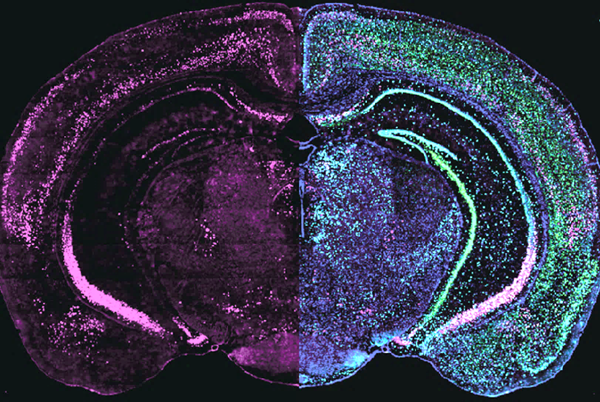By Sarah Melzer
Learning and memory are regulated by specialized neuronal circuits in the cortex. In our recent study we discovered an endogenous signaling molecule, the neuropeptide gastrin-releasing peptide (GRP), that targets these specialized circuits in the cortex of mice to enhance fear memories.
Neuropeptides like GRP are signaling molecules that serve the communication between cells in the brain. Specialized neuropeptide receptors in the ‘receiving’ cells mediate the intracellular response to the arriving neuropeptidergic signal. We found that the neuropeptide receptor for GRP (GRPR) is expressed in a distinct subset of neurons, the so-called ‘VIP cells’. VIP cells are major players in cortical neuronal circuits that regulate learning and memory, a function that is thought to be achieved by the ability of VIP cells to inhibit inhibition in the cortex and thereby increase cortical responses to sensory cues. We therefore hypothesized that GRPR serves to enhance cortical processing and memory through the activation of VIP cells.

Grp mRNA (magenta) was visualized in a coronal slice of the mouse brain using fluorescent in situ hybridization. Two additional common markers were added in the right hemisphere for better visualization of cortical and hippocampal brain areas.
Since neuropeptides are usually released during specific behavioral or environmental events, their actions are thought to temporarily tune neuronal networks to adapt to changing needs. Our results suggest that the neuropeptide GRP is released and activates VIP cells in the cortex specifically during auditory fear conditioning, a task where mice learn to associate an auditory cue with the occurrence of an aversive cue. In control mice, the subsequent presentation of the auditory cue alone triggers fear memories due to the predicted occurrence of the aversive cue. We developed new CRISPR/Cas9 tools to test whether GRP-GRPR signaling facilitates this fear memory. Indeed, CRISPR/Cas9-mediated knockout of the GRP receptor in the auditory cortex of mice decreased the expression of auditory fear memories.
Our findings thus reveal a novel signaling pathway for the regulation of fear memories and provides further evidence that neuropeptidergic pathways in the brain can serve as potential molecular targets for therapeutic treatments to regulate brain functions.
Sarah Melzer is a postdoctoral researcher in Bernardo Sabatini’s lab in the Department of Neurobiology.
Learn more in the original research article:
Bombesin-like peptide recruits disinhibitory cortical circuits and enhances fear memories. Melzer S, Newmark ER, Mizuno GO, Hyun M, Philson AC, Quiroli E, Righetti B, Gregory MR, Huang KW, Levasseur J, Tian L, Sabatini BL. Cell. 2021 Oct 28
News Types: Community Stories
